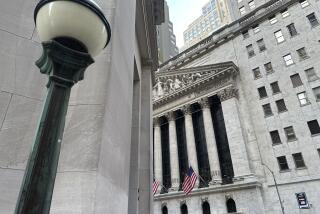As Short-Term Rates Move Up, Trouble Brews
- Share via
Stock market bulls are worried about the recent jump in long-term bond yields, but a potentially more dangerous menace looms: slowly rising short-term interest rates. That’s where many big and small investors alike really focus when making investment decisions.
After all, if you could earn 6% again in a risk-free money market fund, it’s likely that neither stocks nor bonds would hold the same tremendous appeal they’ve had for the last year.
Now, we’re probably not returning to 6% money funds soon. Even so, the rising trend in short-term rates is bringing some investors much closer to their own personal “threshold” yields, which if breached could dramatically slow the torrent of cash pouring into stocks and bonds.
Many professional money managers, for example, judge stocks’ attractiveness relative to returns they can earn on short-term U.S. Treasury bills. Because stocks are inherently risky, while T-bills are virtually risk free, stocks’ potential returns must far exceed T-bill rates to persuade pros that stocks are worth a bet.
As three-month T-bill rates plunged last year, that investment became far less attractive, while stocks became more attractive based on hopes for an economic recovery. Now that a recovery apparently has begun, however, investors anticipate greater demand for money and higher inflation. That is pushing interest rates up. The three-month T-bill rate has rebounded to 4.02% from its 20-year low of 3.72% reached last month.
That may not seem like much of a rise. But because stock prices are at all-time highs, many pros are ratcheting down their expectations for additional price gains in the near future. That means it takes a lower Treasury bill rate to tip the risk-versus-return equation in favor of T-bills.
“We’ve got our finger on the trigger,” admits Kurt Winrich at Winrich Capital Management, an Orange County money manager. The firm now has 80% of its $250 million in assets in stocks--the highest percentage since 1985. But if the T-bill rate hits 4.3%, Winrich says, he may begin selling stocks and shifting to lower-risk investments.
Elaine Garzarelli, a widely followed analyst at Shearson Lehman Bros. in New York, has been one of the stock market’s biggest bulls over the past year. But she too is nervous about the increase in short-term rates. What’s her “threshold” yield? “A 4.6% T-bill rate would be dangerous,” she tells clients in her latest market letter.
A much more important question, though, is how soon rising short-term rates might alter small investors’ decisions. Disgusted with low yields, individuals have pulled billions of dollars out of money funds and bank certificates of deposit over the past year. Much of that money has flowed into stocks and bonds, generally via mutual funds.
As T-bill rates rebound, they are pulling up other short-term rates. Bank Rate Monitor newsletter of North Palm Beach, Fla., reports that banks and S&Ls; have begun raising CD yields again, after cutting them almost nonstop for 34 months. The national average yield on six-month CDs inched up to 3.90% last week from 3.89% the previous week, the newsletter says.
Again, that isn’t much. But it’s the trend that counts. If an economic recovery means that interest rates have finally stopped falling--and that there’s reason to believe they’ll gradually rise in 1992--many individuals who’ve been fleeing banks and money funds may just decide to stay put. And that could significantly reduce the dollars flowing into the stock market. Longer-term, stocks should benefit from a healthier economy. In the short run, though, this red-hot market would be vulnerable if the money spigot suddenly shut off.
Nobody expects interest rates to rise substantially at this point. Indeed, as long as the Federal Reserve insists that credit should remain relatively loose to help the economy, there’s almost no chance of seeing even 5% short-term rates soon. William Sullivan, economist at Dean Witter Reynolds, believes that the T-bill rate won’t get much higher than 4.25% in the near term.
The danger is that the emotion accompanying signs of an economic rebound could cause a brief spike in short-term rates that would take everyone by surprise. If 4% turns out to be a “threshold” yield for too many investors, long-term investments may quickly become casualties.
Short Rates on the Rise Interest rates on 3-month U.S. Treasury bills-a benchmark for short-term rates in general-have begun to rise, after falling sharply through most of 1991. 3-month T-Bill discount rate, end of month figures except latest 1992: Tues. 4.02% Source: Federal Reserve Bank of St. Louis
More to Read
Inside the business of entertainment
The Wide Shot brings you news, analysis and insights on everything from streaming wars to production — and what it all means for the future.
You may occasionally receive promotional content from the Los Angeles Times.










